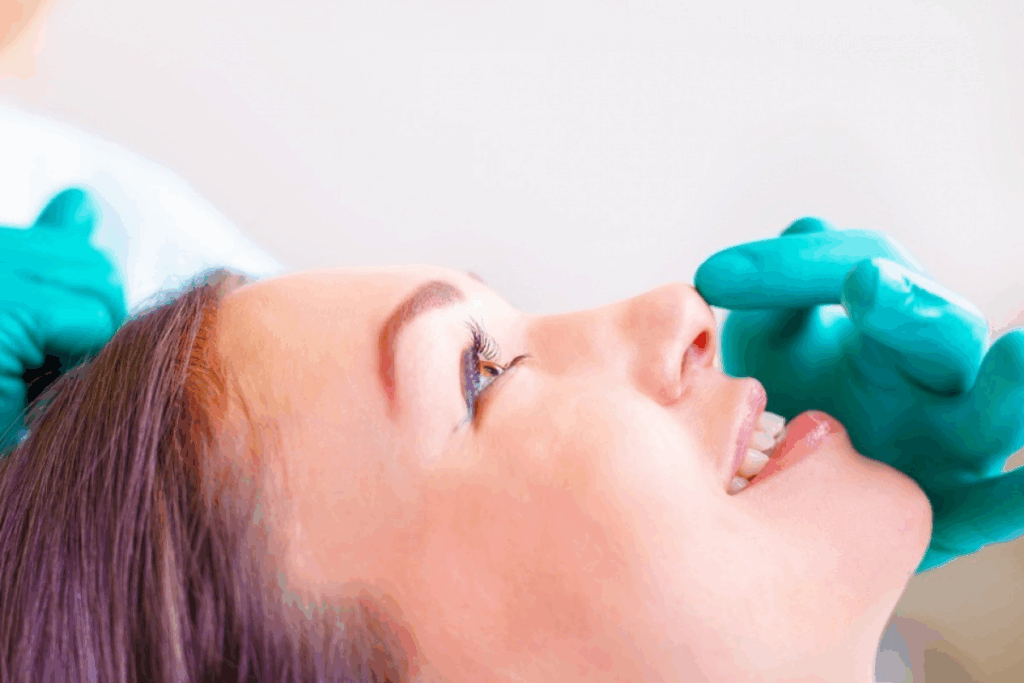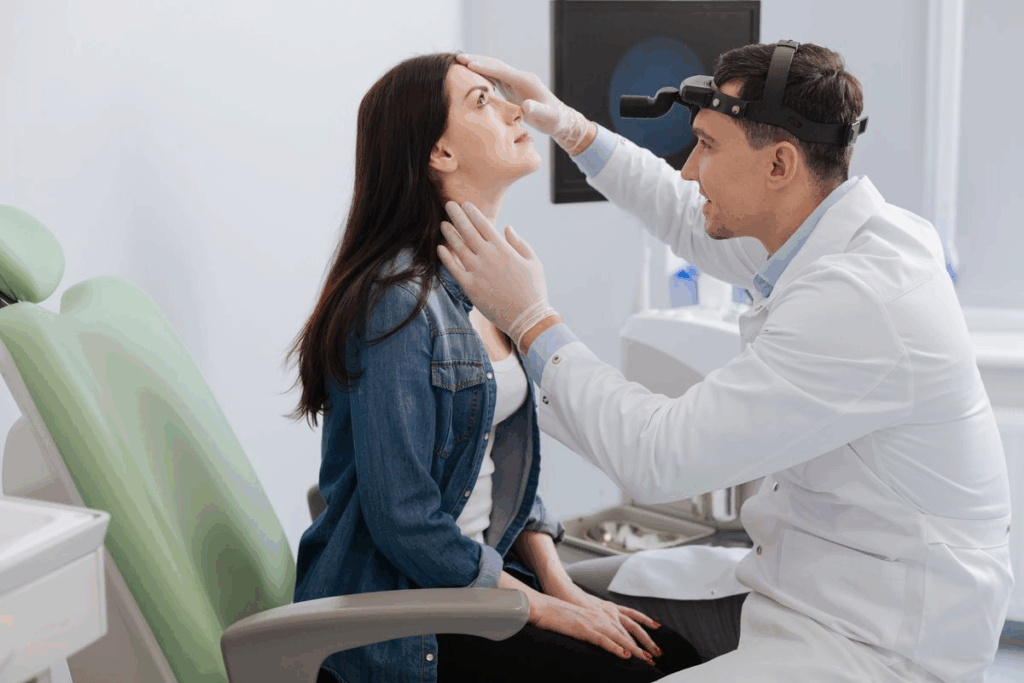
A deviated septum happens when the thin wall between your nasal passages is crooked. This can cause a lot of discomfort and affect your health. How to know if you have a deviated septum: Look for persistent difficulty breathing through one nostril, recurrent infections, or nosebleeds.
About 80 percent of people have some nasal septum deviation. But many don’t show symptoms. For others, it can lead to one-sided nasal congestion, headaches, or sleep problems.
To know if your nasal septum deviation is a problem, look for signs and get a professional check-up. At Liv Hospital, we offer detailed tests and care to help with deviated septum issues.

The nasal septum is a wall made of cartilage and bone. It divides the nasal cavity into two nostrils, helping us breathe. A deviated septum happens when this wall is crooked, making one nostril smaller than the other.
The nasal septum supports the nose. A deviated septum means it’s crooked, blocking airflow. The Mayo Clinic says a deviated septum makes one nostril smaller.
Deviated septum is quite common. Many people have some degree of septal deviation. We’ll look at how widespread this condition is.
Population Studied | Prevalence of Deviated Septum |
General Population | 80% |
Patients with Nasal Symptoms | 90% |
A normal septum is straight, dividing the nasal passages evenly. A deviated septum is crooked, causing breathing problems. The severity of the deviation affects symptoms.
“A deviated septum can cause significant nasal obstruction and breathing difficulties, impacting an individual’s quality of life.”
Knowing the difference between a normal and deviated septum is key to treating nasal issues.

Many things can cause a deviated septum, like being born with it, injuries, or changes as we age. Knowing why it happens helps people understand their condition and what treatments are available.
Some people are born with a deviated septum, known as congenital nasal septal deviation. This happens when the nasal septum doesn’t form right during fetal development or shifts during birth. Congenital factors can make a deviated septum noticeable at birth or later in life.
Nasal trauma or injury is another big reason for septal deviation. A hit to the nose can move the nasal septum. This can happen during sports, accidents, or fights. Injury and trauma can cause the nasal cartilage and bone to move out of place.
As we get older, the nasal septum can shift due to aging. The cartilage and bone in the nose can weaken and move, causing a deviated septum. Age can also make existing septal deviations worse, making symptoms more noticeable.
Cause | Description | Common Symptoms |
Congenital Factors | Present at birth or develops during growth | Nasal congestion, difficulty breathing |
Injury and Trauma | Nasal trauma causing septal displacement | Nasal pain, swelling, breathing difficulties |
Age-Related Changes | Weakening and shifting of nasal cartilage and bone | Increased nasal congestion, snoring |
Understanding why a deviated septum happens helps people choose the right treatment. It’s about making informed decisions for their care.
Knowing the signs of a deviated septum is key. It can cause anything from mild discomfort to serious health issues. If you’re experiencing these symptoms, it’s time to see a doctor.
Asymmetrical breathing difficulties are a common sign. This happens when the septum blocks one nostril more than the other. You might find it easier to breathe through one nostril than the other.
Chronic nasal congestion is another common symptom. The septum’s deviation can cause turbulence, leading to swelling and congestion. This congestion often doesn’t go away with usual decongestants.
Sinus pressure and pain are linked to a deviated septum. The abnormal airflow and pressure can cause sinus infections and facial pain. This pain can be mild or severe, sometimes accompanied by headaches.
Noisy breathing or snoring during sleep can be a sign. The obstruction from the deviated septum can cause turbulent airflow. This can lead to noisy breathing or snoring, and in severe cases, sleep apnea.
The following table summarizes the primary symptoms of a deviated septum:
Symptom | Description |
Asymmetrical Breathing Difficulties | Breathing more easily through one nostril than the other due to obstruction. |
Chronic Nasal Congestion | Persistent congestion not relieved by typical decongestants. |
Sinus Pressure and Pain | Facial pain and pressure, potentially leading to sinus infections. |
Noisy Breathing or Snoring | Turbulent airflow during sleep, potentially contributing to sleep apnea. |
A deviated septum can cause many secondary problems that affect your life a lot. These issues can be as bad as the main symptoms. Sometimes, they can even be worse.
One big problem is getting sinus infections over and over. The way air flows and drains because of the septum can cause chronic sinusitis. This makes it easier to get sick.
Another issue is nosebleeds that happen a lot. The uneven airflow can dry out and crack the nasal mucosa. This leads to nosebleeds, which can be a big problem.
People with a deviated septum often have trouble sleeping. The stuffiness and breathing problems can make it hard to sleep well. This can hurt your health and happiness.
Facial pain and headaches are also common. The pressure and congestion in the nose can spread to the face. This causes pain and discomfort.
It’s important to know about these secondary symptoms and complications. They show how much a deviated septum can affect your health. By understanding these issues, we can see why we need to treat and manage them well.
Checking for a deviated septum involves looking, breathing tests, and tracking symptoms. These steps can’t replace a doctor’s diagnosis. But, they help spot possible signs and guide you to see a healthcare provider.
Looking into your nasal passages can hint at a deviated septum. Use a mirror and a bright light to see inside your nostrils. Carefully tilt your head back and shine the light into your nostrils to see the nasal septum and any deviations. Look for any unevenness or blockages in the nasal passages.
Breathing tests can show how well your nasal passages work. Try closing one nostril at a time and breathe in and out to compare airflow. If one nostril is much harder to breathe through, it might mean you have a deviated septum.
Tracking your symptoms can give clues about a deviated septum. Keep a journal or log of nasal congestion, breathing trouble, or other symptoms. Note the frequency and severity of these symptoms to spot patterns.
When tracking symptoms, consider:
By using visual checks, breathing tests, and symptom tracking, you can learn a lot about your nasal health. If your self-checks suggest a deviated septum, seeing a healthcare provider for a proper check-up and treatment is key.
It’s important to know the difference between a deviated septum and other nasal problems. Many issues can look similar, making it hard to tell them apart. But, it’s key for the right treatment.
Nasal polyps are growths in the nasal passages, often from allergies or inflammation. They cause congestion and can make it hard to smell. “Nasal polyps are linked to chronic inflammation, while a deviated septum is a physical blockage.” Polyps usually affect both sides, while a deviated septum can be worse on one side.
Chronic sinusitis means the sinuses are inflamed for over 12 weeks. A deviated septum can make sinusitis worse by blocking drainage. But, they are different conditions. Chronic sinusitis brings facial pain, thick discharge, and a reduced sense of smell. A deviated septum mainly causes nasal blockage and can lead to sinusitis.
Allergic rhinitis is an allergic reaction in the nasal passages, often from pollen or dust. It can look like a deviated septum with congestion and sneezing. But, itchy eyes and nose are common with allergic rhinitis, not with a deviated septum.
“Allergic rhinitis is an immune response, whereas a deviated septum is a structural anomaly.”
Knowing the difference is key for the right treatment. Allergic rhinitis might need antihistamines or shots, while a deviated septum might need surgery.
Healthcare providers can give better care by knowing the differences. Accurate diagnosis is the first step to feeling better.
Knowing when to see a doctor is key for those with deviated septum symptoms. Some may handle their symptoms on their own. But others might need a doctor’s help to figure out the best treatment.
Some symptoms mean you should see a doctor. Severe nasal congestion that won’t go away, frequent nosebleeds, and constant sinus infections are signs you need medical help. If you’re experiencing these, make an appointment with a healthcare professional.
The Mayo Clinic says a blocked nostril that doesn’t get better, frequent nosebleeds, or other concerning symptoms mean you should see a doctor. It’s important to take care of your health and get checked if you’re not sure about your symptoms.
A deviated septum can really affect your life. It can mess with your sleep, daily activities, and overall happiness. If your symptoms are getting in the way of your life, it’s time to see a doctor. They can check how serious your condition is and suggest the right treatment.
In some cases, a deviated septum can cause serious problems that need quick medical help. Severe difficulty breathing, severe facial pain, or signs of infection like fever and swelling are emergency signs. If you or someone you know has these symptoms, get medical help right away.
Going to the doctor can be tough, but knowing the signs can help you make good health choices. If you’re experiencing any symptoms, don’t wait to see a healthcare provider for the right care and treatment.
Getting an accurate diagnosis is key to treating a deviated septum well. We know that a detailed diagnostic process is vital. It helps find the main cause of nasal blockage and symptoms.
The first step is a thorough physical check-up. A healthcare provider will look into the nasal passages with a nasal speculum. This lets them see the nasal septum and other areas clearly.
They will also look at the patient’s medical history and symptoms. This helps decide what to do next in the diagnosis.
Next, a nasal endoscopy might be done. This uses a camera and light to see inside the nasal cavity. It helps spot any blockages or problems.
Imaging tests might be needed too. These include CT scans and MRI. They give detailed pictures of the nasal cavity and sinuses.
These images help find any issues like sinusitis. They are important for planning the right treatment.
By using findings from physical exams, nasal endoscopy, and imaging, doctors can make a precise diagnosis. This approach ensures patients get the best care for their needs.
Treating a deviated septum can vary a lot. It depends on how bad the symptoms are and what the patient needs. Some people might just need simple fixes, while others might need surgery like septoplasty.
For many, the first step is to try conservative approaches. This means using nasal strips to open up the nose and humidifiers to add moisture. These can help make breathing easier.
Making lifestyle changes is also important. For example, sleeping with your head raised can help. Also, staying away from things that make your nose worse is key.
If simple steps don’t work, medication options are next. Decongestants can help by shrinking the nose. Antihistamines might be needed if allergies are causing trouble.
Nasal corticosteroids can also help by reducing swelling. Always talk to a doctor about the right medicine and how much to take.
If a deviated septum is really bad, or if other treatments don’t work, septoplasty might be suggested. This surgery fixes the septum to improve breathing.
Septoplasty is done under anesthesia. The doctor makes an incision, fixes the septum, and puts it back in place.
After septoplasty, you might feel stuffy and swollen. This can be managed with pain meds and saline rinses. Most people can get back to normal in a week or two, but avoid hard work for a bit.
Knowing what to expect during recovery is important. Following your doctor’s advice closely can help avoid problems.
A deviated septum can really affect how well you live. It’s important to know what causes it, its symptoms, and how to treat it.
We talked about the main symptoms like breathing problems and stuffy noses. Getting a proper diagnosis is key. This includes physical checks, nasal endoscopy, and imaging tests.
There are many ways to treat a deviated septum, from simple methods to surgery. Recognizing symptoms and getting medical help can really help. In short, knowing about deviated septums and getting the right treatment can greatly improve life quality.
We want to help you understand deviated septums better. Knowing the signs and getting medical help is the first step. This way, you can manage your symptoms and feel better.
A deviated septum is when the thin wall between the nasal passages is off-center. This makes one side smaller than the other.
A deviated septum is quite common. It’s estimated that up to 80% of people have some degree of septal deviation.
The main symptoms include trouble breathing, nasal congestion, and sinus pressure. You might also notice noisy breathing or snoring.
Yes, it can. Complications include sinus infections, nosebleeds, sleep issues, and facial pain or headaches.
You can check yourself by looking in the mirror, checking your breathing, and tracking your symptoms.
A deviated septum is a structural issue. Nasal polyps are growths on the nasal lining, often due to inflammation.
See a doctor if your symptoms are severe, affect your daily life, or if you have emergency signs like trouble breathing or nosebleeds.
Diagnosis involves a physical exam, nasal endoscopy, and imaging like CT scans.
Treatment can be conservative, include medications, or surgery like septoplasty. It depends on the severity.
Yes, mild cases might not need surgery. They can be managed with conservative methods and medications.
To find out, see a healthcare provider. They can check your symptoms and do tests to diagnose.
After septoplasty, expect some nasal congestion, swelling, and bruising. These usually go away in a few weeks. You’ll get advice on care and follow-up visits.
Subscribe to our e-newsletter to stay informed about the latest innovations in the world of health and exclusive offers!
WhatsApp us